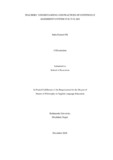
Please use this identifier to cite or link to this item:
https://hdl.handle.net/20.500.14301/483| Title: | Teachers’ Understanding and Practices of Continuous Assessment System in ELT Class |
| Authors: | Oli, Indra Kumari |
| Citation: | Oli.I.K.(2024).Teachers’ understanding and practices of continuous assessment system in ELT class. |
| Issue Date: | Dec-2024 |
| Publisher: | Kathmandu University School of Education |
| School: | SOED |
| Department: | DOLE |
| Level: | M.Phil. |
| Program: | Master of Philosophy (MPhil) in English Language Education |
| Abstract: | The Internal Assessment (IA) system was newly introduced in the curriculum of school-level education in 2020. The previous curriculum (2009) adopted a continuous assessment system (CAS) as an assessment tool for learning. However, the studies and reports discovered that it was not implemented effectively as anticipated. The teachers found it cumbersome and filled out the CAS form for formality only. Therefore, the new curriculum revised the CAS system of providing ticks to the students and incorporated a rubrics system under various criteria. The internal assessment also suggests that the teacher should assess the students as part of their teaching-learning and update their progress on portfolios for record keeping and self evaluation of the students. Therefore, this research aimed to explore teachers’ understanding of internal assessment through experiences in ELT classes at the basic level of education. The study followed the phenomenological qualitative approach to collect the participants' experiences on the phenomena. The study purposively selected three basic-level English language teachers from public schools in Surkhet. Semi-structured interviews were employed as a technique for in-depth information on the phenomenon. Similarly, field notes, artefacts and document analysis were also used for data collection and triangulation. The theoretical framework carried out by this study was the Social Cultural Theory of Vygotsky to view the dynamics of language instruction, motivation, and evaluation in the classroom context. The findings revealed a nuanced picture of discrepancies between perception and praxis. On the one hand, the English language teachers expressed positive perceptions towards internal assessment, highlighting its ability to improve academic achievement and engage students in active learning. However, they could not adhere to all the criteria as directed by the curriculum in praxis due to some practical constraints like poor understanding of the CAS, large class size, workload, lack of resources in school, etc. They also complained about the unavailability of training and orientation, as well as the monitoring system for implementing IA. I explored IA as a supportive tool for increasing the students’ grades without actually enhancing the learners’ skills. The teachers’ preference for traditional paper-pencil tests suggests a need for additional support, extrinsic motivation, and resources to facilitate the transformation towards a more authentic use of assessment. Teachers should feel IA empowers them to regulate the students and minimize their burden and workload leading the students to independent learning. It can be concluded that the dominance of assessment of learning marginalized the assessment for learning and assessment as learning. Therefore, a more balanced approach is needed to maintain the assessment as learning and assessment for learning. With the expanding theoretical insights into the cognitive dimensions of IA experience, this study provides viable implications for educators, policymakers, researchers, and teachers in English education for effective IA praxis. The findings suggest the justifiable praxis of IA in the classroom and aspire to future research to explore the perspectives and consequences of IA on students’ lives. |
| URI: | https://hdl.handle.net/20.500.14301/483 |
| Appears in Collections: | Dissertation |
Files in This Item:
| File | Description | Size | Format | |
|---|---|---|---|---|
| Indra Kumari Oli_Dissertation Draft version_ January 13, 2025.pdf | 2.79 MB | Adobe PDF |  View/Open |
Items in DSpace are protected by copyright, with all rights reserved, unless otherwise indicated.